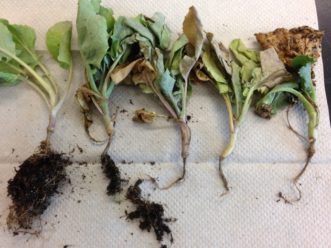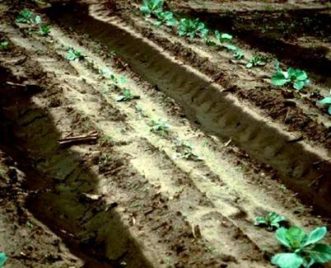Wirestem is a disease of young vegetable brassica (cole crop) plants that affects both direct-seeded and transplanted crops. The primary symptom is dark lesions of varying depth and length on the hypocotyl (seedling stem) at or just above the soil line. Lesions often extend down the root. When wirestem is severe, the entire outer layer of the taproot rots away, leaving only the tough water-conducting tube in the center of the root (figure 1). Lateral roots also rot.
Secondary aboveground symptoms associated with lesions that girdle the stem include wilting, stunting, and a blue color to the youngest leaves (figure 1). Moist soil may stick to the lesions, held there by the fungal pathogen.
Wirestem can occur on greenhouse-grown transplants if potting mix becomes contaminated or is mixed with infested native soil.
Wirestem can kill plants outright. Just as important, surviving plants may be stunted permanently and never produce a harvestable yield. Because of stand loss and stunted plants, wirestem reduces the number and weight of marketable-sized heads of cabbage and broccoli or collard plants per acre (figure 2).

Figure 1. Dark lesions on the lower stem, especially ones girdling the stem, or thin, dark dry tap roots are reliable symptoms to diagnose wirestem. Plants with severe wirestem symptoms (as shown in this figure) likely will not survive. Note the one healthy plant on the left with a good fibrous root system.
The Pathogen
The soilborne fungus that causes wirestem is Rhizoctonia solani. This pathogen also causes pre-emergence damping-off of cole crops and bottom rot of cabbage. In the southeastern United States, the most prevalent and damaging type of R. solani that attacks cole crops is type AG 4.1 Because AG 4 attacks a wide variety of vegetables and is adapted to survive in soil, crop rotation often will not control wirestem.
Another type of R. solani, AG 2-1, also causes wirestem. It is usually found on farms that grow cole crops repeatedly in the same fields, as this type of R. solani prefers to attack cole crops. Rotation with non-cole crops for three or more years can reduce wirestem outbreaks when R. solani AG 2-1 is the primary cause.
The Host Crop
All cole crop vegetables in the species Brassica oleracea are all susceptible to wirestem.1 These crops include the leafy greens collard and kale and heading cole crops like cabbage, broccoli, and cauliflower. Other cruciferous vegetables, such as mustard, turnip, and rutabaga, belong to different Brassica species and are less susceptible than B. oleracea. All cruciferous vegetables become less susceptible as their stems thicken with age.
Favorable Environments
In the southeastern United States, wirestem is more common and severe in the fall than in the spring. This is because the pathogen is most active in warm, moist soil.2
Susceptible crops grown in heavy soils with loam and clay tend to have more wirestem than crops grown in sandy soil.
When legume crops, such as clovers, vetches, and beans, are disked into soil, the green residue increases the amount and activity of Rhizoctonia in soil by providing a food base for the fungus.3 High soil nitrogen levels enable Rhizoctonia to attack plant stems quickly. Excess nitrogen also makes plants tender and susceptible.
Management
Soil Preparation before Planting
- Choose a well-drained field and use raised beds.
- Deep plow to turn over the top six inches of soil, as this layer has the highest levels of Rhizoctonia in it.3
- Use rye or small grains other than wheat as rotation crops, because they generally are not susceptible to the types of R. solani that cause wirestem. Avoid planting legume cover crops immediately before cole crops, or disk legume cover crops four weeks before transplanting or seeding cole crops, so there is time for the cover crop to partially decay.4
At Planting
- Grow less susceptible cultivars of cole crops, such as ‘Blue Max’ collard. No cultivars are truly resistant, however.1
- Fertilize transplants as little as possible before transplanting. Nitrogen delays hardening of transplants and can make them more susceptible to wirestem.
- Do not set transplants too deeply into the soil. Cover only the root ball and as little of the stem as possible. Shallow planting is the most important cultural practice to prevent wirestem.
- Apply fungicides in the row before transplanting or as directed sprays to young transplants. For more information on fungicides, see the current edition of the Southeastern U.S. Vegetable Crop Handbook.5
If purchased transplants have wirestem when they are received from the transplant producer, and healthy replacement transplants cannot be found, a crop still may be grown successfully with slightly diseased transplants. First, discard transplants with girdling lesions that cover three-quarters or more of the stem circumference. Second, set remaining transplants shallowly in soil as described above. Third, apply fungicide. Most plants that survive six weeks after transplanting will produce a marketable-sized head.6
References
- Keinath AP, Farnham MW. Differential cultivars and criteria for evaluating resistance to Rhizoctonia solani in seedling Brassica oleracea. Plant Dis. 1997. 81(8):946–952. doi:10.1094/PDIS.1997.81.8.946.
- Keinath AP. Relationships between inoculum density of Rhizoctonia solani, wirestem incidence and severity, and growth of cabbage. Phytopathology. 1995. 85(12):1487–1492. https://www.apsnet.org/publications/phytopathology/backissues/Documents/1995Articles/Phyto85n12_1487.pdf.
- Papavizas, GC, Adams, PB, Lumsden, RD, Lewis, JA, Dow, RL, Ayers, WA, and Kantzes, JG. Ecology and epidemiology of Rhizoctonia solani in field soil. Phytopathology. 1975. 65:871–877. https://www.apsnet.org/publications/phytopathology/backissues/Documents/1975Articles/Phyto65n08_871.pdf.
- Keinath AP, Harrison HF, Marino PC, Jackson DM, and Pullaro TC. Increase in populations of Rhizoctonia solani and wirestem of collard with velvet bean cover crop mulch. Plant Dis. 2003. 86(6):719–725. doi:10.1094/PDIS.2003.87.6.719.
- Kemble JM, senior editor. Meadows IM, Jennings KM, Walgenbach JF, editors. Vegetable crop handbook for the southeastern US. Willoughby (OH): MeisterMedia Worldwide. 2019. Growing Produce. https://www.growingproduce.com/southeasternvegetablecrophandbook/.
- Keinath AP, Farnham MW. Effect of wirestem severity on survival and head production of transplanted broccoli and cabbage. Plant Dis. 2001. 85(6):639–643. doi:10.1094/PDIS.2001.85.6.639.


